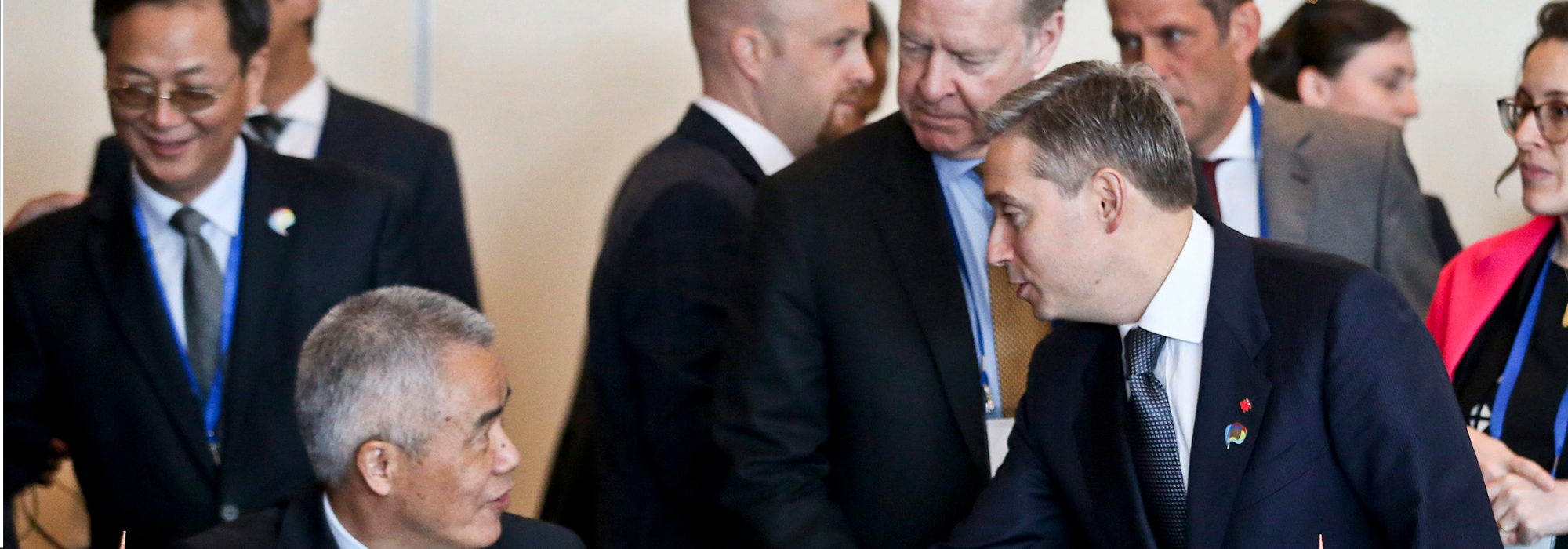
I had the impression that Canada was a player in international trade when I went to work for the Canadian Federation of Agriculture (CFA) in the late 1990s. But that’s not what I observed during a short stint with Canada’s main farm lobby.
Gone were the days when Canadian negotiators set the global trade agenda alongside its counterparts from the United States, the European Union and Japan. The CFA spent much of its time reacting to an agenda shaped by the push and pull between the US, the EU and some newer power-brokers: Australia, the champion of small, open farming economies, and the emerging markets of China and India.
I don’t know that things have changed much since then. We talk about Canada as a “trading nation,” yet the only thing that Canadian companies do exceptionally well is sell their excess production to the neighbouring country that speaks the same language, shares its values and happens to be the most voracious consumer on Earth. Others recognize this and take Canada less seriously as a result. Canada still has a place in the dramatis personae, but it had been upstaged by hungrier actors.
Prime Minister Justin Trudeau seems to desire a starring role. “Canada is back,” he said in his speech at the Paris climate talks in April. But why did Canada go away? Experts such as Robert Wolfe of Queen’s University speak highly of Canada’s negotiators, so we can’t blame the bureaucracy. A schizophrenic agriculture policy is an issue, but not the most important one. The problem is us. We’ve focused almost exclusively on the United States since the 1980s. The Canada-US Free Trade Agreement was great for the country, but it exacerbated the gravitational pull of the world’s largest economy. It was like donning blinders. The opportunity cost can be measured in the tens of billions: in 2013, demand for Canadian exports would have been $60 billion higher had we had the same exposure to emerging markets as to the US, according to Tiff Macklem, former deputy governor at the Bank of Canada and now dean of the Rotman School of Business, University of Toronto.
This will sound like an old lament for some, but there is reason to come back to it now. Canada has been presented with an unexpected opportunity to take back its place at the head table of international trade. The election of Donald Trump was supposed to inspire copycats. Instead, many of the nations with which Canada wants to do business are clamouring for more trade. Canada could be a player, but only if we avoid losing ourselves in the renegotiation of the North American Free Trade Agreement. The NAFTA talks must be the priority, of course; they needn’t become our sole preoccupation.
It should be clear by now that the US isn’t a bottomless well of demand for our stuff. More competitive exporters such as China, Mexico and Germany are winning market share in the US at Canada’s expense. This would be a small concern if Canada were returning the favour. It’s not: since 2000, Canada’s share of global merchandise trade has shrunk to about 2.5 percent from 4.3 percent, while its share of the market for commercial services has dropped by a percentage point to about 1.7 percent.
The failure is in Asia. Compared to its peers, Canada missed out on the hyper-growth phase of China’s remarkable rise from poverty. The US did a free trade deal with South Korea three years sooner than Canada. Asia’s fourth-largest economy has struggled in recent years, but export data suggest American companies have retained more business there than Canadian ones. In 2016, US exports to South Korea were 5.5 percent lower than in 2011, while Canada suffered a 15 percent decline over the same period.
Head starts matter. So does orientation. Australia and Canada completed trade agreements with South Korea at roughly the same time. (Australia’s went into effect in December 2014, Canada’s in January 2015.) Yet there is no comparing the economic impact. In 2016, Australia sent merchandise goods to South Korea worth (US) $11.7 billion, while Canada shipped only (US) $3.3 billion, according to the International Monetary Fund’s Direction of Trade Statistics. Australia’s advantage is ambition, not proximity: Vancouver is about 150 kilometres closer to Seoul than is Sydney. Canada’s disadvantage is complacency.
Little Canada might be growing up. Trudeau insisted that the NAFTA renegotiation would be a trilateral discussion, ignoring old-timers who wanted to Ottawa to abandon Mexico. The enthusiasm around the Canada-EU trade agreement is encouraging. Canada’s business associations now push for greater access to China and other Asian nations almost as forcefully as they insist Ottawa keep the US border open — an important shift. It also is significant that both the foreign affairs minister and the trade minister have spent most of their adult lives abroad. Former prime minister Stephen Harper and his cabinet had significant experience in only one country: Canada. To do business in the world, it helps to have lived in it.
Still, there is reason to question whether Trudeau is really committed to doing trade differently. There is no mention of the World Trade Organization (WTO) in International Trade Minister François-Philippe Champagne’s mandate letter, an omission that Wolfe interprets as telling. Chrystia Freeland’s reboot of Canada’s foreign policy in June was followed by big announcements by Defence Minister Harjit Sajjan and International Development Minister Marie-Claude Bibeau. Champagne was left out, suggesting it’s business as usual when it comes to trade.
That business does appear to include a greater emphasis on Asia. There is specific mention in Champagne’s mandate letter of China and India, two countries with which Trudeau has suggested he would like to secure free trade agreements. Certainly, Canada must keep open the possibility of gaining improved access to two markets with populations that each exceed 1 billion people. But the odds of a win are so remote that it’s fair to ask whether Trudeau is just name-dropping. Canada would be at an overwhelming disadvantage in a negotiation with China, and therefore Trudeau must proceed carefully. India, meanwhile, where bilateral talks with Canada have been painfully slow, has shown no inclination to trade with anyone on terms other than its own. It will take more than appointing four Sikh cabinet ministers to secure a breakthrough with India; otherwise, there would have been one by now.
Since NAFTA will consume so much bandwidth, Trudeau would be better off practising the art of the possible when it comes to the non-US elements of his trade strategy. There are three things he could do.
One, offer the WTO more than rhetorical support. The federal government insists it prefers multilateral trade agreements, yet its emphasis on bilateral talks with China, India and Japan suggests otherwise. The WTO badly needs a champion, and it’s in Canada’s interest to step up. Canada has a certain amount of protection in NAFTA from the capricious use of punitive tariffs by the US. The Trump administration has said it plans to rewrite those provisions. Canada may come to need the WTO more than it has in recent years.
Second, Trudeau should invest fully in the effort to save the Trans-Pacific Partnership (TPP). Canada may never again have an opportunity to take part in a significant, multi-country trade negotiation that isn’t dictated by either the US or China. Carlo Dade of the Canada West Foundation and Dan Ciuriak of the Centre for International Governance Innovation calculate that Canada would actually do better in an 11-country TPP than it would if the US were still in the mix. Some of the gain would come from securing improved access to Japan for Canadian farmers, ahead of their American rivals, which would make up for falling behind with South Korea.
Finally, Trudeau should allow Champagne to accumulate as many frequent-flyer points as he wants. My experience abroad over the past decade leaves me with the impression that Canada is far from top of mind when entrepreneurs and executives think about where they could do business. That’s because Canada isn’t in their faces enough. We tend to characterize international sales missions as boondoggles, while other countries accept that promotion simply is part of the game. “To be honest, we’re just catching up,” Champagne told Maclean’s in July. He was talking about his hyperactive travel schedule, which requires explanation only because it’s been so long since we’ve had a trade minister who spends most of his time actually trying to boost trade.
Later, Champagne told Maclean’s, “Opening trade agreements, for me, is key, but it’s an enabler. The next thing is getting there to make sure you sell something.”
It’s the right mix. Stick with it — and don’t let Trump get in the way.
This article is part of the Trade Policy for Uncertain Times special feature.
Photo: Francois-Philippe Champagne, right, Minister of International Trade and Global Affairs of Canada, shakes hands with the Special Representative of the Government of China for Latin American Affairs, Yin Hengmin, during a meeting of the Trans-Pacific Partnership in Vina del Mar, Chile, Wednesday, March 15, 2017. Representatives from countries that signed the failed Trans-Pacific Partnership met in Chile to discuss a possible new regional trade deal, the first time the nations had met after US President Donald Trump withdrew from the deal. (AP Photo/Esteban Felix).
Do you have something to say about the article you just read? Be part of the Policy Options discussion, and send in your own submission. Here is a link on how to do it. | Souhaitez-vous réagir à cet article ? Joignez-vous aux débats d’Options politiques et soumettez-nous votre texte en suivant ces directives.








